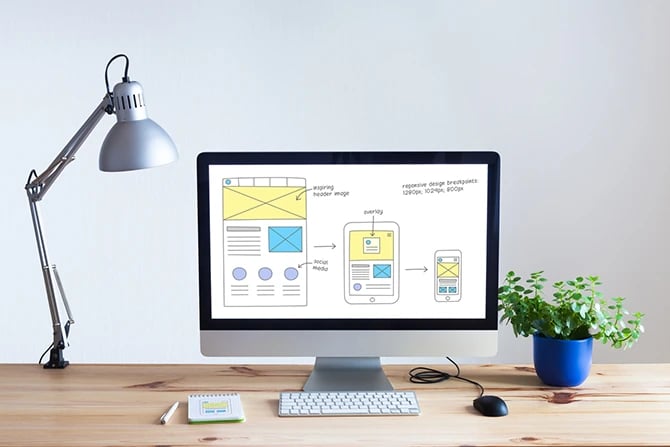We Are Here to Help!
What to Expect from Us:
No Pressure, Just Service!
Get no obligation pricing details and strategies that will work for your business.
B2B websites today are integral components of a broader B2B marketing strategy, far surpassing their traditional role as mere digital brochures. Even though social media is an effective platform for a B2C audience, more is needed for B2B interactions. Websites have evolved into dynamic platforms crucial in various business processes, including lead generation and customer service. A B2B website provides a vital first impression and actively shapes and influences client relationships. As the digital forefront of a company, a website opens up avenues for new business opportunities. The change in a website's role reflects the growing importance of holistic digital strategies in the B2B sphere, where websites are pivotal in connecting and engaging with clients in the digital domain.
Integrating Artificial Intelligence (AI) and chatbots into B2B website design represents a forward-thinking approach to business communication and customer engagement. As businesses strive to offer more personalized, efficient, and intuitive online experiences, leveraging these advanced technologies is essential.

The Importance of a B2B Website
A B2B website is a foundational element of a company's identity and a pivotal tool for establishing credibility and authority within an industry. As per insights from Marketing Charts, B2B websites play a significant role in the customer journey, influencing decisions at various stages of the buying process. The benefits of a well-designed B2B website are manifold:
- Enhanced Visibility: A strong online presence is indispensable for attracting potential customers and partners. A B2B website acts as the primary point of online discovery, making it crucial for businesses to be easily found and recognized. Effective Search Engine Optimization (SEO) ensures that the website ranks higher in search engine results, increasing visibility and drawing in a targeted audience.
- 24/7 Accessibility: A major advantage of a B2B website is its constant availability, offering an always-open window to your business. It ensures that clients and prospects can access information, resources, and support irrespective of geographical and time constraints. Around-the-clock accessibility can be particularly crucial in global markets, where businesses operate across different time zones.
- Showcasing Products and Services: A website is an ideal platform for showcasing the breadth and depth of a company's offerings. Detailed product descriptions, service outlines, case studies, and testimonials provide visitors with a comprehensive understanding of what the business offers and its value proposition.
- Lead Generation: A well-optimized B2B website is a powerful tool for lead generation. Businesses can convert visitors into potential leads by strategically designing the website to attract and engage the right audience. An appealing design, intuitive navigation and content, and clear call-to-action (CTA) prompts guide visitors to make inquiries or availing service
- Customer Engagement and Support: Having a website for B2B marketing serves as an interactive platform where businesses can connect with prospects. Through features like contact forms, chatbots, and support forums, websites facilitate direct communication, query resolution, and customer feedback.
- Building Trust and Authority: By providing valuable content such as industry insights, whitepapers, and blog posts, a B2B website can establish a business as a thought leader in its field. Combining it with thoughtful social media marketing, you can educate prospective customers and build trust--key factors in the B2B buyer's decision-making process.
B2B Web Design: Essential Elements
An effective B2B website design requires a strategic approach that balances functionality, user experience, and content delivery. A well-planned B2B website effectively communicates your brand message, engages your target audience, and facilitates business processes, making it a crucial tool in your B2B marketing strategy.
Each category and element plays a distinct and crucial role in creating a successful B2B website, collectively contributing to a site that attracts and engages visitors and converts them into loyal customers.
Design and User Experience
Design your website with the potential B2B customer in mind, ensuring an intuitive and user-friendly experience that caters to their specific needs and preferences. Focusing on the aesthetic and navigational aspects of a B2B website to capture and retain visitor attention. The goal is to match the standards of the best B2B websites by creating a design that reflects the unique identity and values of your B2B brand.

- Professional and Clean Design: An effective B2B website should have a professional look with a clean, uncluttered layout. Use easy-to-read fonts and a color scheme that aligns with your B2B brand.
- Intuitive Navigation: A clear and intuitive navigation structure is crucial. Menus should be easy to locate and use, guiding visitors efficiently to the information they seek.
- Responsive Website Design: The website must be mobile-friendly, ensuring it is easily navigable and looks great on all devices, from desktops to smartphones.
Content and Messaging
Messaging on the best B2B websites is often more formal and centered around ROI, efficiency, and long-term value. A B2C website tends to have more visually appealing content emphasizing storytelling, promotions, and emotional appeal. For a B2B business, conveying the brand's value proposition and engaging the target audience requires crafting a compelling narrative about the company's offerings. Focus on creating content that resonates with the B2B audience, establishes the brand's authority, and encourages visitor engagement and conversions.
- Strong Value Proposition for Professional Services: Ensure that your website clearly describes the range of professional services you offer, detailing how they cater to the B2B market. Articulate your value proposition on the homepage. Visitors should immediately understand what your company does and how it can help them.
- High-Quality Content: Use your website to enhance brand awareness through effective content marketing strategies. Feature content that speaks to your experience and success in B2B advertising and B2B sales, demonstrating how you drive results for your clients. Include well-written, informative content that speaks to your B2B audience, including product descriptions, blog posts, case studies, whitepapers, and industry insights.
- Calls to Action (CTAs): Effective CTAs guide visitors to take desired actions, such as signing up for a newsletter, downloading a resource, or contacting sales.
Technical and Functional Aspects
The behind-the-scenes features of a B2B website ensure it operates smoothly, securely, and efficiently. Technical and functional aspects cover critical components vital for a website’s performance, security, and ability to attract and nurture leads. A B2B business must optimize technical aspects like website speed, responsiveness, and user journey to cater specifically to the needs of a B2B business audience.
- SEO Optimization: Implement B2B Search Engine Optimization (B2B SEO) best practices throughout your B2B web design to ensure high visibility in search engines. Aside from using Google search ads, you can attract your target audience effectively by using relevant keywords, optimizing meta tags, and creating quality backlinks.
- Contact Information and Forms: Make it easy for visitors to contact you. Display contact information prominently and include simple, straightforward contact forms.
- Integration with Marketing Tools: Integrate your website with marketing automation tools, CRM systems, and Google Analytics for better tracking and lead management.
- Security Features: Implement security measures like SSL certificates to protect your site and user data, especially for B2B transactions.
- Accessibility: Ensure your website is accessible to users with disabilities, adhering to WCAG guidelines. Include considerations for screen readers, color contrast, and keyboard navigation.
- Regular Updates and Fresh Content: Instruct your B2B marketer to keep your website updated and maintained to keep up with evolving web standards and SEO practices.
Trust and Credibility Building
The customer journey involves marketers nurturing leads with in-depth content and personalized communication over time. Purchasing decisions in the B2B space are often significant and require a high level of confidence in the provider. The trustworthiness and credibility of a business are crucial to establishing it as a reliable and credible entity in its industry, fostering trust with potential prospects and partners.
- Customer Testimonials and Case Studies: Use testimonials and case studies from B2B customers to build credibility, especially those highlighting successful B2B sales outcomes.
- Social Proof and Trust Signals: Leverage trust signals such as certifications, awards, and partnerships to reinforce brand awareness and establish your reputation as a trusted B2B brand.

Integrating AI and ChatBots to Your Business Website
Artificial Intelligence (AI) is a broader term for machines or software that can perform tasks that typically require human intelligence. These tasks include learning, reasoning, problem-solving, perception, and language understanding. AI encompasses a wide range of technologies and applications, from simple algorithms used in calculators to complex systems like self-driving cars or virtual assistants.
On the other hand, chatbots are a specific application of AI designed to simulate conversation with human users. Chatbots are programs that use AI techniques, particularly natural language processing (NLP), to understand and respond to user inputs in a natural, conversational manner. Chatbots can be as simple as rule-based systems that respond to specific keywords or phrases or as advanced as systems that use machine learning to adapt and react more naturally over time.
Integrating AI and chatbots in your B2B website design sets a new standard for customer engagement and operational excellence. These technologies can significantly enhance the user experience, making interactions more engaging, efficient, and tailored to the needs of B2B clients.
Here's how businesses can effectively apply these technologies to their B2B websites:
1. Automated Customer Journey
Providing instantaneous customer service and support is vital in a fast-paced digital environment. AI and chatbots revolutionize this aspect by offering automated, real-time assistance to website visitors.
Chatbots for Instant Assistance
- Chatbots can offer quick help with navigation, detailed product information, and efficient troubleshooting, ensuring a consistent and responsive customer service experience. You can even use social media chat functionality, such as Facebook Messenger, and connect it to your website.
Troubleshooting and Technical Support
- Utilize chatbots to offer step-by-step guidance for common technical issues, significantly reducing the load on the human customer service team on routine inquiries.
2. Personalized User Experience
Personalization is key in B2B transactions. AI enables a more tailored web experience, making interactions more relevant and engaging for each B2B audience.
Behavior-Based Customization
- AI can analyze user interactions and tailor the website experience, offering personalized content and product recommendations.
Interactive Product Demos
- Integrate AI-driven demos that dynamically adjust based on user input, demonstrating the functionality and benefits of your products in real time.
3. Lead Generation and Qualification
Generating and qualifying leads are crucial processes in B2B marketing. AI and chatbots streamline these tasks, making them more efficient and effective.
Automated Lead Collection
- Use chatbots to gather essential information from potential leads for targeted follow-up, such as contact details and specific business needs.
Qualifying Leads through Conversations
- Apply AI algorithms to evaluate chat conversations, identifying high-potential leads for more focused sales efforts.
4. Website Traffic Data Collection and Analysis
Collecting and analyzing website traffic and user behavior data is crucial for continuous improvement. AI excels in processing this data to offer actionable insights.
Customer Feedback
- Solicit and compile user feedback using your website or social media accounts through chatbots to provide insights into customer preferences and areas for improvement.
User Behavior Insights
- Use AI to analyze data on user interactions, optimizing the website's design and functionality based on these insights.

5. Streamlining B2B Transactions
Integrating AI into business processes on B2B websites can significantly enhance efficiency and transaction smoothness. It can help digital marketing efforts and eCommerce operations through streamlined data gathering.
Integration with CRM Systems
- Connecting CRM extensions, like the ones in Adobe Commerce, can ensure seamless data flow and more effective customer relationship management.
Automating Routine Tasks
- Employ AI to handle routine tasks like scheduling, sending reminders, or generating standard quotes, freeing time for a resident B2B marketer to focus on more complex tasks.
eCommerce Platforms
- Automate and optimize various processes, from inventory management to personalized product recommendations. AI can also predict trends and analyze sales data to manage inventory, reducing the likelihood of overstocking or stockouts.
6. Enhanced Content Discovery
Efficient content discovery is pivotal in providing a satisfying user experience on B2B websites. AI can revolutionize this aspect by making content discovery more intuitive and tailored to individual needs.
AI-Powered Search Functions
- Implement AI-enhanced search capabilities that understand natural language queries, improving content discoverability.
Optimized bidding
- B2B marketers can use Google search ads to optimize bids to maximize clicks and balance cost and ad performance in their digital marketing strategy.
Content Recommendations
- Use AI to suggest relevant articles, blog posts, or case studies based on user interests and past interactions.
7. Accessibility and Inclusivity for Potential Prospects
Ensuring that B2B websites are accessible and inclusive to all users is a crucial aspect of modern web design. AI and chatbots play a significant role in enhancing these features.
Voice-Activated Interfaces
- Incorporate voice recognition for hands-free navigation, enhancing accessibility for users with different abilities.
Language Translation and Multilingual Support
- Offer multilingual chatbot support using AI, catering to a diverse, global audience.
8. Continuous Learning and Improvement
The ability to continuously learn and adapt is one of the most valuable features of AI in the context of the best B2B websites. Your credibility as a B2B company rests on your ability to provide accurate and usable data from your user interactions. Products under Adobe Commerce use an AI marketing tool like Adobe Sensei to analyze website visitors deeply to create a tailored shopping experience.
Regular Updates Based on AI Insights
- Using AI to learn the search queries and user interactions, regular updates can improve paid search performance, such as Google ads. A business can restructure its site content to help align with keywords or terms a potential customer commonly uses.

Conclusion
A business website for B2B marketing is a multifaceted asset that goes beyond mere digital presence. It is a strategic tool for visibility, lead generation, customer engagement, and establishing industry credibility, playing a crucial role in the overall B2B marketing strategy and the customer journey. Integrating AI and chatbots into B2B website design marks a transformative step in how businesses engage with their clients in the digital sphere. These advanced technologies bring many benefits, from automating customer service to personalizing user experiences, streamlining business processes, and enhancing content discoverability.
By adopting AI and chatbot functionalities, B2B companies can create a more interactive, efficient, and personalized web experience, which is instrumental in catering to the changing user needs and preferences.
It leads to improved user experiences and deeper insights into customer behavior, enabling businesses to make data-driven decisions. The strategic incorporation of AI and chatbots is crucial to fostering stronger ecommerce relationships between businesses through round-the-clock customer support and securing a competitive edge in the digital marketplace.
Our postcards have helped various businesses get leads, boost awareness, and grow revenue. Let us help you create a marketing postcard design to achieve your goals!

 Cactus Mail Team: Apr 22, 2024
Cactus Mail Team: Apr 22, 2024



